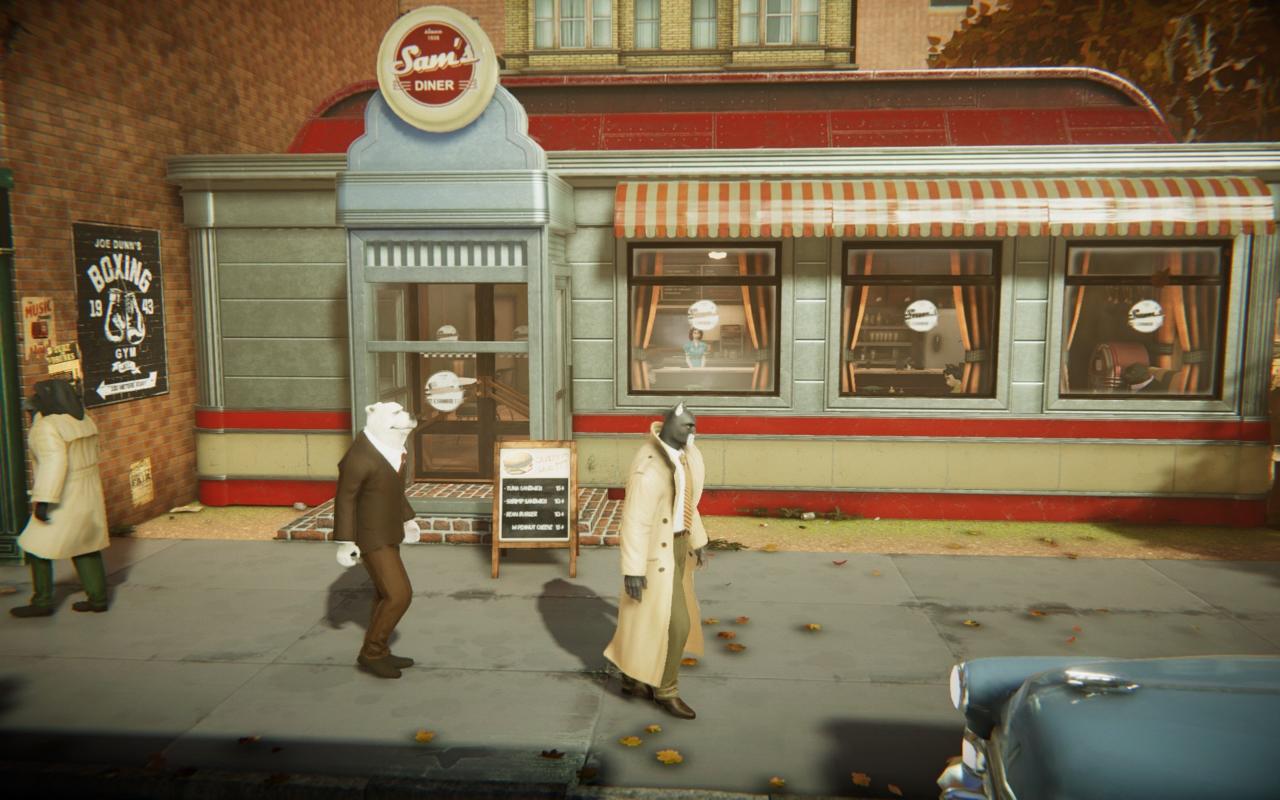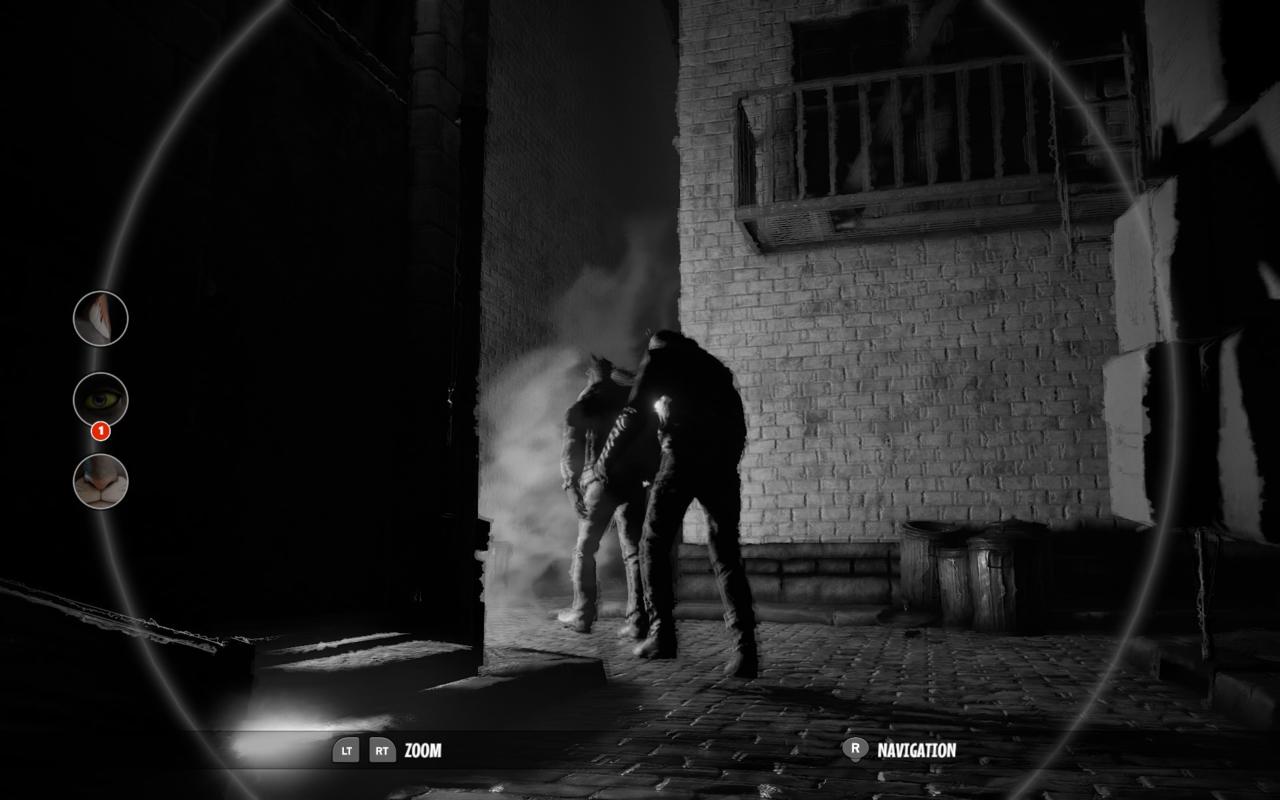It is to damn with faint praise to admit my favourite part of Blacksad: Under the Skin happens within the pause menu. Specifically, the menu option called "Progress." Here you can browse a comic book that tells the story so far, its speech bubbles and illustrated frames altered to reflect the choices you’ve made. The major plot threads remain intact, but you can weave subtle changes. Once the end credits have rolled, the final comic is a tangible reminder of the course you charted throughout the game.
It’s my favourite part of the game not just because it is a meaningful nod towards Blacksad’s origin as a comic book series--created two decades ago in Spain, written in French, and set in a version of 1950s America where all people are depicted as humanoid animals. It’s my favourite part of Blacksad because it gets to the heart of what Blacksad is about: Blacksad himself. It’s a shame such a strong central character finds himself in the middle of a merely competent noir-detective story with a couple of neat ideas and a distinct lack of pizzazz.
Like its source material, the game leans very heavily, if superficially, into the stock imagery of noir fiction. You know the drill: An attractive woman walks into the office of a down-on-his-luck private eye while well-tailored men are beaten up in dark alleyways by other well-tailored men. There’s a trip to the docks at night, a tense poker game against a group of gangsters, and the underbelly of every animal is even more seedy than you imagined, especially the rhinoceros.

In the midst of all this is John Blacksad, the implausibly-named feline private investigator who, when the game opens, finds himself working a tawdry case to expose a cheating husband. This early scene sets the tone and allows you to begin colouring in your version of Blacksad. The husband, furious at having been caught in the act of infidelity, confronts Blacksad and, after violence fails, offers him 10 times what his wife was paying in order to keep quiet. You can choose whether to take the money or not--the money itself is ultimately irrelevant and actually spending it is outside the scope of this story. Determining the character of the man is the whole point.
Later, you have the opportunity to tell the wife the truth of the affair or to keep your promise to the husband, and a box will pop up in the top left corner of the screen, Telltale-style, to inform you whether you’ve lied or accepted a bribe or betrayed a promise depending on the precise sequence of events. Blacksad begins the game as a heartbroken man (his lover was recently killed) and a struggling gumshoe (the bills are piling up in his tiny ramshackle office), but from this starting point you’re given a good deal of freedom to shape his future.
The new case gets underway via a set of mechanics that are staples of the adventure genre, but lack some of the refinements of recent years. Blacksad walks around each location and interacts with hotspots to look at objects and provide a brief observation, pick up items for later use, or talk to people and ask them questions about the case. It’s not a point-and-click interface, however; it uses direct control over Blacksad and he is, rather surprisingly for a cat, a cumbersome figure to move about.

Hotspots only appear when Blacksad moves near them, and they often disappear if he walks too far past them or slightly turns away from them. As a result, navigating a location and revealing all its interactable items can prove a finicky, frustrating process. Time is never of the essence in these scenes, so you’re never punished for being too slow. But you’re never assisted either; Blacksad walks very slowly, and there’s no run modifier or option to quickly exit a screen you’ve already walked across a dozen times. In the mid-game, there’s even a room you must explore in darkness, with only the unreliable light of a Zippo to guide you towards the vital, erratically appearing hotspots. It’s infuriating.
Very little of Blacksad is skippable. You can’t speed up dialogue during conversations. Mashing all the buttons during cutscenes does nothing. When Blacksad looks at a photo on the wall, for example, the camera zooms in on it and then ponderously pans across to a second photo next to it, Blacksad’s inner monologue noting something about the situation. You can’t skip the sequence even if you’ve accidentally triggered the hotspot a second time. I’m a patient player, but Blacksad forces you to move at its pedestrian pace, and it strained even my generous limits.
The investigation fares better when the interrogations commence. The conversation wheel comes in two varieties: The first are a sort of standard, "just the facts, ma’am" set of questions that let Blacksad get a feel for what the other person knows, and the second option provides an opportunity for you to express what Blacksad himself is thinking. The latter set is often how you get to shape Blacksad’s character and, crucially, you only have a few seconds to make the choice.
Conversations can feel quite tense, especially as they go back and forth between timed and non-timed sets of responses. You’re always on your toes, never quite sure when you’re going to be called upon to make a split-second decision about what exactly is going on in Blacksad’s head. It’s effective because, from Under the Skin's opening scene, you’re aware that the game will remember what you said and remind you of your previous decisions when you say something down the line that’s consistent or inconsistent with them.
Two other, somewhat more novel mechanics come to the fore during your investigation. The first plays upon the heightened senses of a cat. At certain prescribed moments you can activate Blacksad’s cat sense and view the world in black-and-white slow motion from a first-person perspective. The idea here is that you’re able to hear, smell, and see things that someone other than a cat wouldn’t pick up on. In practice, all you’re doing is swinging the camera around until you’ve highlighted what you need to find. The slow-motion effect in these sections lends a degree of drama that the scenes might otherwise not possess, but it doesn’t enhance the feeling you’re doing any sort of extraordinary detective work.

What does a much better job of that is the second uncommon feature. Blacksad adds vital clues and important questions to a sort of mental map of the case. You can combine two or more of these to verify a particular detail, rule something out, or suggest a new path to probe. The game will prompt you when you’ve collected enough clues to make a deduction so you’re not constantly opening the menu up and trying things out. In addition, the clues as written do a good job of providing just enough of a hint to nudge you in the direction of which ones to combine, without blatantly giving the game away. Though it’s possible to brute force the correct combinations since there are never more than ten clues to consider at any moment, you’ll be doing a disservice not only to a clever system but to yourself. Putting two pieces of information together, that you suspect clears up an important part of the case, and seeing Blacksad smile and give you a hearty thumbs up to indicate that you did so correctly… man, it’s a marvellously simple and effective way of making the player feel smart.
Effective is a pretty good way of describing Blacksad as a detective game. As a noir detective game, however, it struggles. No matter that this is a world full of cats, dogs, wolves, lizards, rhinos, and horses going about their lives as people, Blacksad’s New York is well-trodden material. The main story does manage to twist and turn in unexpected ways, and the payoff, at least in terms of the central whodunnit mystery, is satisfying. Less successful are the attempts at building a larger world beyond the immediate case. There are gestures towards the racism and sexism in this society--and by implication, modern America--but they're just that, a gesture. There's no follow-up or investigation of these issues; they're just set dressing.

It also lacks a coherent noir style. Blacksad himself offers up a decent take on the noir lead, with his voiceover commentary laced with weary cynicism and flashes of tender empathy. There’s the expected sultry sax soundtrack which, coupled with numerous long, lingering shots of cigarette smoke wafting into the air, ensures everything feels like it’s been smothered in a sticky heat haze. But everything else looks drab and dull and boringly conventional. There’s very little of the high contrast lighting and off-kilter camera angles that defined noir cinema. For a genre synonymous with style, it’s disappointing to see something so lacking in it.
Blacksad: Under the Skin works, it's a solid detective game that serves up a case worth cracking, a charismatic lead whose character you can shape in meaningful ways, and an investigation method that successfully wraps you in a brown trenchcoat. But when it doesn’t work you'll find yourself bogged down in the tedium of traipsing around another uninspired location, searching for that final wayward hotspot, and the atmosphere is sucked out of the room.









